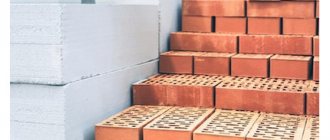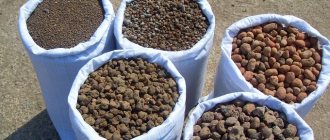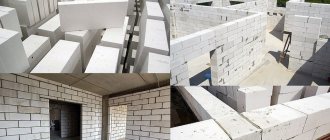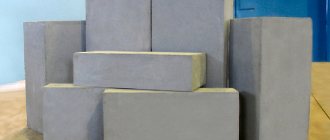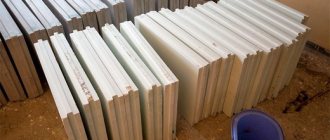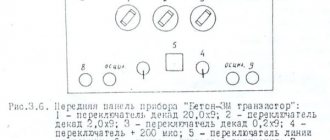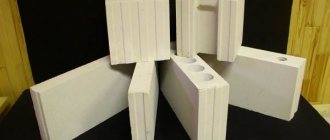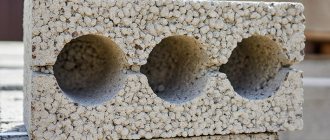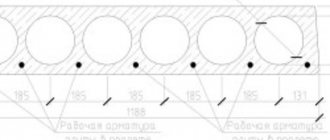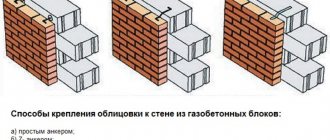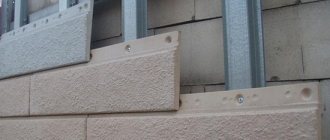Main characteristics of insulation
When choosing insulation materials, you need to pay attention to various factors: the type of structure, the presence of exposure to high temperatures, open fire, and the characteristic level of humidity. Only after determining the conditions of use, as well as the level of thermal conductivity of the materials used for the construction of a certain part of the structure, you need to look at the characteristics of a specific insulation:
- Thermal conductivity. The quality of the insulation process carried out, as well as the required amount of material to ensure the desired result, directly depends on this indicator. The lower the thermal conductivity, the more effective the use of insulation.
- Moisture absorption. This indicator is especially important when insulating the external parts of the structure, which may be periodically exposed to moisture. For example, when insulating a foundation in soils with high water levels or a high level of water content in its structure.
- Thickness. The use of thin insulation allows you to preserve the internal space of a residential building, and also directly affects the quality of insulation.
- Flammability. This property of materials is especially important when used to reduce the thermal conductivity of ground parts of residential buildings, as well as special-purpose buildings. High-quality products are self-extinguishing and do not emit toxic substances when ignited.
- Heat resistance. The material must withstand critical temperatures. For example, low temperatures during outdoor use.
- Environmentally friendly. It is necessary to resort to the use of materials that are safe for humans. Requirements for this factor may vary depending on the future purpose of the structure.
- Soundproofing. This additional property of insulation in some situations allows you to achieve a good level of protection of the room from noise, as well as extraneous sounds.
When a material with low thermal conductivity is used in the construction of a certain part of the structure, you can buy the cheapest insulation (if preliminary calculations allow this).
The importance of a specific characteristic directly depends on the conditions of use and the allocated budget.
Thermal conductivity of bricks, comparison of bricks by thermal conductivity
The thermal conductivity of various types of bricks (silicate, ceramic, facing, refractory) is considered.
A comparison of bricks in terms of thermal conductivity has been made; the thermal conductivity coefficients of refractory bricks at different temperatures are presented - from 20 to 1700°C. The thermal conductivity of a brick depends significantly on its density and configuration of voids. Bricks with lower density have lower thermal conductivity than bricks with high density. For example, chamotte foam, diatomite and insulating bricks with a density of 500...600 kg/m 3 have a low thermal conductivity coefficient, which is in the range of 0.1...0.14 W/(m deg).
Brick, depending on its composition, can be divided into two main types: ceramic (or red) and silicate (or white). The value of the thermal conductivity coefficient of bricks of these types may differ significantly.
Ceramic brick. It is made from high-quality red clay, which makes up about 85-95% of its composition, as well as other components. Such bricks are made by molding, drying and firing at a temperature of about 1000 degrees Celsius. The thermal conductivity of ceramic bricks of various densities is 0.4...0.9 W/(m deg).
According to the scope of application, ceramic bricks are divided into ordinary building bricks, fire-resistant bricks and facing bricks. Facing decorative (cladding) brick has a smooth surface and uniform color and is used for exterior cladding of buildings. The thermal conductivity of facing brick is 0.37...0.93 W/(m deg).
Sand-lime brick. It is made from purified sand and differs from ceramic in composition, color and thermal conductivity. The thermal conductivity of sand-lime brick is slightly higher and ranges from 0.4 to 1.3 W/(m deg).
Comparison of bricks by thermal conductivity at 15...25°C
| Brick | Density, kg/m 3 | Thermal conductivity, W/(m deg) |
| Foam chamotte | 600 | 0,1 |
| Diatomite | 550 | 0,12 |
| Insulating | 500 | 0,14 |
| Silica | — | 0,15 |
| Trepelny | 700…1300 | 0,27 |
| Facing | 1200…1800 | 0,37…0,93 |
| Silicate slotted | — | 0,4 |
| Ceramic red porous | 1500 | 0,44 |
| Ceramic hollow | — | 0,44…0,47 |
| Silicate | 1000…2200 | 0,5…1,3 |
| Slag | 1100…1400 | 0,6 |
| Ceramic red dense | 1400…2600 | 0,67…0,8 |
| Silicate from those. voids | — | 0,7 |
| Clinker solid | 1800…2200 | 0,8…1,6 |
| Chamotte | 1850 | 0,85 |
| Dinas | 1900…2200 | 0,9…0,94 |
| Chromite | 3000…4200 | 1,21…1,29 |
| Chromomagnesite | 2750…2850 | 1,95 |
| Heat-resistant chromium-magnesite | 2700…3800 | 4,1 |
| Magnesite | 2600…3200 | 4,7…5,1 |
| Carborundum | 1000…1300 | 11…18 |
The thermal conductivity of a brick also depends on its structure and shape:
- Hollow brick - made with voids, through or blind, and has lower thermal conductivity compared to a solid product. The thermal conductivity of hollow bricks ranges from 0.4 to 0.7 W/(m deg).
- Solid - used, as a rule, in the main construction of load-bearing walls and structures and has a high density. Solid silicate and ceramic bricks conduct heat 1.5-2 times better than hollow bricks.
Kiln or refractory brick. Manufactured for use in aggressive environments, used for laying stoves, fireplaces or thermal insulation of rooms exposed to high temperatures. Refractory brick has good heat resistance and can be used at temperatures up to 1700°C.
The thermal conductivity of refractory bricks at high temperatures increases and can reach 6.5...7.5 W/(m deg). Foam chamotte and diatomite bricks have lower thermal conductivity compared to other refractories. The thermal conductivity of such a brick at the maximum temperature of use (850...1300°C) is only 0.25...0.3 W/(m deg). It should be noted that the thermal conductivity of fireclay brick, which is traditionally used for laying stoves, is higher and equal to 1.44 W/(m deg) at 1000°C.
Thermal conductivity of refractory bricks depending on temperature
| Brick | Density, kg/m 3 | Thermal conductivity, W/(m deg) at temperature, °C | ||||||
| 20 | 100 | 300 | 500 | 800 | 1000 | 1700 | ||
| Diatomite | 550 | 0,12 | 0,14 | 0,18 | 0,23 | 0,3 | — | — |
| Dinas | 1900 | 0,91 | 0,97 | 1,11 | 1,25 | 1,46 | 1,6 | 2,1 |
| Magnesite | 2700 | 5,1 | 5,15 | 5,45 | 5,75 | 6,2 | 6,5 | 7,55 |
| Chromite | 3000 | 1,21 | 1,24 | 1,31 | 1,38 | 1,48 | 1,55 | 1,8 |
| Foam chamotte | 600 | 0,1 | 0,11 | 0,14 | 0,17 | 0,22 | 0,25 | — |
| Chamotte | 1850 | 0,85 | 0,9 | 1,02 | 1,14 | 1,32 | 1,44 | — |
- Physical quantities. Directory. A. P. Babichev, N. A. Babushkina and others; edited by I. S. Grigorieva - M.: Energoatomizdat, 1991 - 1232 p.
- V. Blasi. Designer's Handbook. Construction physics. M.: Tekhnosphere, 2004.
- Tables of physical quantities. Directory. Ed. acad. I. K. Kikoina. M.: Atomizdat, 1976. - 1008 p. construction physics, 1969 - 142 p.
- Mikheev M. A., Mikheeva I. M. Fundamentals of heat transfer. M.: Energy, 1977 - 344 p.
- Kazantsev E.I. Industrial furnaces. Reference manual for calculations and design.
- H. Wang. Basic formulas and data on heat transfer for engineers. Directory. M.: Atomizdat. 1979 - 212 p.
- Chirkin V.S. Thermophysical properties of nuclear technology materials. Directory.
Comparison of popular insulation materials
Let's look at several materials used to improve the energy efficiency of buildings:
- Mineral wool. Made from natural materials. It is resistant to fire and is environmentally friendly, as well as low thermal conductivity. But the inability to withstand the effects of water reduces the possibilities of use.
- Styrofoam. Lightweight material with excellent insulation properties. Affordable, easy to install and moisture resistant. Disadvantages: good flammability and release of harmful substances during combustion. It is recommended to use it in non-residential premises.
- Balsa wool. The material is almost identical to mineral wool, only differs in improved moisture resistance. It is not compacted during manufacturing, which significantly extends its service life.
- Penoplex. The insulation resists moisture, high temperatures, fire, rot, and decomposition well. It has excellent thermal conductivity, is easy to install and durable. Can be used in places with maximum requirements for the material’s ability to withstand various influences.
- Penofol. Multilayer insulation of natural origin. Consists of polyethylene, pre-foamed before production. May have different porosity and width indicators. Often the surface is covered with foil, thereby achieving a reflective effect. It is distinguished by its lightness, ease of installation, high energy efficiency, moisture resistance, and low weight.
When choosing a material for use in close proximity to humans, it is necessary to pay special attention to its environmental friendliness and fire safety characteristics. Also, in some situations, it is rational to buy more expensive insulation, which will have additional moisture protection or sound insulation properties, which ultimately allows you to save money.
Comparison using a table
| N | Name | Density | Thermal conductivity | Price, euro per cubic meter | Energy costs for | ||
| kg/cub.m | min | Max | European Union | Russia | kW*h/cubic m. | ||
| 1 | cellulose wadding | 30-70 | 0,038 | 0,045 | 48-96 | 15-30 | 6 |
| 2 | fibreboard | 150-230 | 0,039 | 0,052 | 150 | 800-1400 | |
| 3 | wood fiber | 30-50 | 0,037 | 0,05 | 200-250 | 13-50 | |
| 4 | flax fiber whales | 30 | 0,037 | 0,04 | 150-200 | 210 | 30 |
| 5 | foam glass | 100-150 | 0.05 | 0,07 | 135-168 | 1600 | |
| 6 | perlite | 100-150 | 0,05 | 0.062 | 200-400 | 25-30 | 230 |
| 7 | cork | 100-250 | 0,039 | 0,05 | 300 | 80 | |
| 8 | hemp, hemp | 35-40 | 0,04 | 0.041 | 150 | 55 | |
| 9 | cotton wool | 25-30 | 0,04 | 0,041 | 200 | 50 | |
| 10 | sheep's wool | 15-35 | 0,035 | 0,045 | 150 | 55 | |
| 11 | duck down | 25-35 | 0,035 | 0,045 | 150-200 | ||
| 12 | straw | 300-400 | 0,08 | 0,12 | 165 | ||
| 13 | mineral (stone) wool | 20-80 | 0.038 | 0,047 | 50-100 | 30-50 | 150-180 |
| 14 | glass fiber wool | 15-65 | 0,035 | 0,05 | 50-100 | 28-45 | 180-250 |
| 15 | expanded polystyrene (pressless) | 15-30 | 0.035 | 0.047 | 50 | 28-75 | 450 |
| 16 | extruded polystyrene foam | 25-40 | 0,035 | 0,042 | 188 | 75-90 | 850 |
| 17 | polyurethane foam | 27-35 | 0,03 | 0,035 | 250 | 220-350 | 1100 |
The indicator of thermal conductivity properties is the main criterion when choosing an insulation material. All that remains is to compare the pricing policies of different suppliers and determine the required quantity.
Insulation is one of the main ways to obtain a structure with the required energy efficiency. Before making your final choice, carefully determine the conditions of use and, armed with the table provided, make the right choice.
Comparison of thermal conductivity of building materials by thickness updated: November 2, 2020 by: kranch0
It is better to start the construction of each facility with project planning and careful calculation of thermal parameters. Accurate data will be obtained from a table of thermal conductivity of building materials. Proper construction of buildings contributes to optimal indoor climate parameters. And the table will help you choose the right raw materials to be used for construction.
Purpose of thermal conductivity
Thermal conductivity is a measure of the transfer of thermal energy from heated objects in a room to objects at a lower temperature. The heat exchange process is carried out until the temperature indicators are equalized. To indicate thermal energy, a special thermal conductivity coefficient of building materials is used. The table will help you see all the required values. The parameter indicates how much thermal energy is passed through a unit area per unit time. The larger this designation, the better the heat exchange will be. When constructing buildings, it is necessary to use a material with a minimum thermal conductivity value.
The thermal conductivity coefficient is a value that is equal to the amount of heat passing through a meter of material thickness per hour. The use of such a characteristic is mandatory to create better thermal insulation. Thermal conductivity should be taken into account when selecting additional insulating structures.
What influences the thermal conductivity index?
Thermal conductivity is determined by the following factors:
Porosity determines the heterogeneity of the structure. When heat is passed through such materials, the cooling process is insignificant;
An increased density value affects close contact between particles, which promotes faster heat transfer;
High humidity increases this indicator.
Using thermal conductivity values in practice.
The materials are presented in structural and thermal insulation varieties. The first type has high thermal conductivity. They are used for the construction of floors, fences and walls.
Using the table, the possibilities of their heat transfer are determined. In order for this indicator to be low enough for a normal indoor microclimate, walls made of some materials must be especially thick. To avoid this, it is recommended to use additional thermal insulating components.
Thermal conductivity indicators for finished buildings. Types of insulation.
When creating a project, you need to consider all ways of heat leakage. It can come out through walls and roofs, as well as through floors and doors. If you carry out design calculations incorrectly, you will have to be content only with the thermal energy received from heating devices. Buildings built from standard raw materials: stone, brick or concrete need to be additionally insulated.
Additional thermal insulation is carried out in frame buildings. At the same time, a wooden frame gives rigidity to the structure, and insulating material is laid in the space between the posts. In buildings made of brick and cinder blocks, insulation is done from the outside of the structure.
When choosing insulation materials, you need to pay attention to factors such as humidity levels, the influence of elevated temperatures and the type of structure. Consider certain parameters of insulating structures:
The thermal conductivity index affects the quality of the heat-insulating process;
Moisture absorption is of great importance when insulating external elements;
Thickness affects the reliability of insulation. Thin insulation helps preserve the usable area of the room;
Flammability is important. High-quality raw materials have the ability to self-extinguish;
Thermal stability reflects the ability to withstand temperature changes;
Environmental friendliness and safety;
Sound insulation protects against noise.
The following types of insulation are used:
Mineral wool is fire resistant and environmentally friendly. Important characteristics include low thermal conductivity;
Polystyrene foam is a lightweight material with good insulation properties. It is easy to install and is moisture resistant. Recommended for use in non-residential buildings;
Basalt wool, unlike mineral wool, has better resistance to moisture;
Penoplex is resistant to humidity, elevated temperatures and fire. It has excellent thermal conductivity, is easy to install and durable;
Polyurethane foam is known for such qualities as non-flammability, good water-repellent properties and high fire resistance;
Extruded polystyrene foam undergoes additional processing during production. Has a uniform structure;
Penofol is a multi-layer insulating layer. The composition contains foamed polyethylene. The surface of the plate is covered with foil to provide reflection.
Bulk types of raw materials can be used for thermal insulation. These are paper granules or perlite. They are resistant to moisture and fire. And among organic varieties, you can consider wood fiber, flax or cork. When choosing, pay special attention to such indicators as environmental friendliness and fire safety.
NOTE! When designing thermal insulation, it is important to consider the installation of a waterproofing layer. This will avoid high humidity and increase resistance to heat transfer.
Table of thermal conductivity of building materials: features of indicators.
The table of thermal conductivity of building materials contains indicators of various types of raw materials that are used in construction. Using this information, you can easily calculate the thickness of the walls and the amount of insulation.
How to use the table of thermal conductivity of materials and insulation?
The table of heat transfer resistance of materials presents the most popular materials. When choosing a specific thermal insulation option, it is important to take into account not only physical properties, but also characteristics such as durability, price and ease of installation.
Did you know that the easiest way to install penoizol and polyurethane foam. They are distributed over the surface in the form of foam. Such materials easily fill the cavities of structures. When comparing solid and foam options, it should be emphasized that foam does not form joints.
The values of heat transfer coefficients of materials are in the table.
When making calculations, you should know the heat transfer resistance coefficient. This value is the ratio of the temperatures on both sides to the amount of heat flow. In order to find the thermal resistance of certain walls, a thermal conductivity table is used.
You can do all the calculations yourself. To do this, the thickness of the heat insulator layer is divided by the thermal conductivity coefficient. This value is often indicated on the packaging if it is insulation. Home materials are measured independently. This applies to thickness, and the coefficients can be found in special tables.
The resistance coefficient helps to select a specific type of thermal insulation and the thickness of the material layer. Information on vapor permeability and density can be found in the table.
If you use the tabular data correctly, you will be able to choose high-quality material to create a favorable indoor microclimate. published
- The concept of thermal conductivity
- Thermal conductivity during construction
The construction of any house, be it a cottage or a modest country house, must begin with the development of a project. At this stage, not only the architectural appearance of the future structure is laid down, but also its structural and thermal characteristics.
The main task at the project stage will be not only the development of strong and durable structural solutions capable of maintaining the most comfortable microclimate at minimal cost. A comparative table of thermal conductivity of materials can help you make your choice.
Thermal conductivity of concrete: classification, coefficient table
Often, a home craftsman must choose materials to build or renovate structures, so it is important to pay attention to various characteristics. The thermal conductivity of concrete is one of them. This property may differ between species. The thermal conductivity is mainly affected by the type of filler. The lighter the material, the higher its thermal insulation, and the heavier the part, the stronger it is.
Determination of thermal conductivity
Different materials are used in the construction of various buildings and structures. Due to the rather harsh climate, additional insulation is often necessary. For example, when constructing residential premises, special insulators are used to maintain a comfortable temperature for living. Therefore, when choosing building materials, it is imperative to pay attention to their thermal insulation properties.
Thermal conductivity is the ability of a body to transfer energy from hotter parts to cooler parts. The process can occur both in the solid parts of the part and in its pores. In solid parts this is conduction, in pores it is convection. The material cools faster in its hard parts. Air stagnates in the pores, as a result of which the material retains heat longer.
Dependence on various indicators
The thermal insulation characteristics of concrete, brick, plasterboard, wood and many other building materials depend on a number of parameters. For example:
- Moisture.
- Porosity.
- Densities.
The more pores in a part, the warmer it is, and the heavier building material, the stronger it is. In modern construction conditions, various types of materials are used. But they can be conditionally divided into two main ones - these are heavy and light foamy types.
Heavy grade concrete can also be divided into two types : heavy and extra heavy. To enhance strength, various fillers are added to the second type - magnetite, metal bond, barite, etc. Particularly heavy concrete is used in the construction of objects that require protection from radiation. The density of the material in this category starts from 2500 kg/cubic. m.
Ordinary heavy concrete is made with the addition of granite, diabase, limestone, based on mountain crushed stone. The density of the material here varies from 1500 to 2500 kg/cubic. m.
Light grade concrete can also be divided into two groups. Quite often in construction work, types based on porous filler are used, which are slag, expanded clay, pumice, etc.
To make the second group, a regular filler is used, which foams during the kneading process. The result is a material with a very large number of pores.
The thermal insulation of lightweight concrete is, of course, high, but the strength is much lower than that of heavy concrete. Such building materials are used in the construction of buildings that are not subject to serious overloads.
Cellular concrete can be divided according to purpose:
- Thermal insulating (density up to 800 kg/cub.m).
- Structural and heat-insulating (density up to 1350 kg/cubic m).
- Structural (up to 1850 kg/cub.m).
Thermal insulation blocks are most often used to insulate walls that were built from brick or cement mortar. In addition, small enclosing structures can be built from such concrete.
Structural-heat-insulating and simply structural types include expanded clay concrete, slag pumice concrete, foam concrete, etc. They can be used as a thermal insulation and building material.
Effect of moisture
It is a well-known statement in construction circles that dry building materials insulate heat much better than wet ones. This is explained by the rather high degree of thermal conductivity of water. Walls, ceilings, and floors are protected from the cold thanks to the pores in the building material filled with air. When exposed to moisture, air is displaced. This leads to an increase in the heat transfer coefficient of concrete.
During the cold season, moisture that gets into the material freezes , which leads to even more tragic consequences. The degree of susceptibility of a material to moisture permeability may differ from one brand to another.
The thermal conductivity coefficient of concrete and reinforced concrete is 0.18−1.75 W/m*K. Table of thermal conductivity of concrete and other materials:
The concept of thermal conductivity
In general terms, the process of thermal conduction is characterized by the transfer of thermal energy from more heated particles of a solid to less heated ones. The process will continue until thermal equilibrium occurs. In other words, until the temperatures become equal.
In relation to the building envelope (walls, floor, ceiling, roof), the heat transfer process will be determined by the time during which the temperature inside the room becomes equal to the ambient temperature.
The longer this process takes, the more comfortable the room will feel and more economical in operating costs.
Numerically, the heat transfer process is characterized by the thermal conductivity coefficient.
The physical meaning of the coefficient shows how much heat passes through a unit of surface per unit time. Those. the higher the value of this indicator, the better the heat is conducted, which means the faster the heat exchange process will occur.
Accordingly, at the design stage it is necessary to design structures whose thermal conductivity should be as low as possible.
Return to contents
Factors influencing the thermal conductivity value
The thermal conductivity of materials used in construction depends on their parameters:
- Porosity – the presence of pores in the structure of a material disrupts its homogeneity. When a heat flow passes, part of the energy is transferred through the volume occupied by pores and filled with air. It is accepted to take the thermal conductivity of dry air (0.02 W/(m*°C)) as a reference point. Accordingly, the larger the volume occupied by air pores, the lower the thermal conductivity of the material will be.
- Pore structure – the small size of the pores and their closed nature help reduce the rate of heat flow. In the case of using materials with large communicating pores, in addition to thermal conductivity, heat transfer processes by convection will be involved in the heat transfer process.
- Density - at higher values, particles interact more closely with each other and are more conducive to the transfer of thermal energy. In general, the thermal conductivity values of a material depending on its density are determined either on the basis of reference data or empirically.
- Humidity – the thermal conductivity value for water is (0.6 W/(m*°C)). When wall structures or insulation get wet, dry air is displaced from the pores and replaced with drops of liquid or saturated moist air. Thermal conductivity in this case will increase significantly.
- The effect of temperature on the thermal conductivity of a material is reflected through the formula:
λ=λо*(1+b*t), (1)
where, λо – thermal conductivity coefficient at a temperature of 0 °C, W/m*°C;
b – reference value of the temperature coefficient;
t – temperature.
Return to contents
Brick heat transfer coefficient: general information
Brick heat transfer coefficient
The thermal conductivity of a brick is characterized by its ability to conduct heat energy. Such “talent” is usually displayed in a special indicator. Each species will present its own data in this regard:
- Clinker brick has a thermal conductivity in the range from 0.8 to 0.9 W/m K.
- The thermal conductivity of sand-lime brick depends on the number of voids it contains (for a slotted brick it will be equal to 0.4 W/m K), for those with technical voids the figure rises to 0.66, and for a solid version the data will already be 0.8 W/m TO.
- Ceramic bricks also have different thermal conductivity coefficients (depending on the type presented): the thermal conductivity coefficient of a solid brick gives figures from 0.5 to 0.8, slotted brick has 0.34-0.43, and porous brick has 0.22 W/m K The thermal conductivity of a ceramic brick with pores inside will be approximately 0.57 W/m K (however, even these figures may depend on the pores located in it).
As part of this analysis, it must be noted that the heat transfer coefficient of brick is not yet the highest - aerated concrete, for example, is an even better conductor. In order for the buildings being built to be truly warm, it is necessary to combine many components during construction, the main one of which will be the number of pores.
Practical application of the thermal conductivity value of building materials
The concept of the thickness of the material layer directly follows from the concept of thermal conductivity to obtain the required value of heat flow resistance. Thermal resistance is a standardized value.
A simplified formula that determines the thickness of the layer will look like:
where, H – layer thickness, m;
R – heat transfer resistance, (m2*°С)/W;
λ – thermal conductivity coefficient, W/(m*°С).
This formula, when applied to a wall or ceiling, has the following assumptions:
- the enclosing structure has a homogeneous monolithic structure;
- the building materials used have natural moisture.
When designing, the necessary standardized and reference data are taken from the regulatory documentation:
- SNiP23-01-99 – Construction climatology;
- SNiP 23-02-2003 – Thermal protection of buildings;
- SP 23-101-2004 – Design of thermal protection of buildings.
Return to contents
Table of thermal conductivity of thermal insulation materials
To make it easier to keep your house warm in winter and cool in summer, the thermal conductivity of walls, floors and roofs must be at least a certain figure, which is calculated for each region. The composition of the “pie” of walls, floor and ceiling, the thickness of the materials are taken into account so that the total figure is no less (or better yet, at least a little more) recommended for your region.
Heat transfer coefficient of modern building materials for enclosing structures
When choosing materials, it is necessary to take into account that some of them (not all) conduct heat much better in conditions of high humidity. If such a situation may occur for a long period of time during operation, the thermal conductivity for this condition is used in the calculations. The thermal conductivity coefficients of the main materials used for insulation are given in the table.
Name of material /Thermal conductivity coefficient W/(m °C)
Thermal conductivity of materials: parameters
A conventional division of materials used in construction into structural and thermal insulation has been accepted.
Structural materials are used for the construction of enclosing structures (walls, partitions, ceilings). They are distinguished by high thermal conductivity values.
The values of thermal conductivity coefficients are summarized in Table 1:
Table 1
By substituting into formula (2) the data taken from the regulatory documentation and the data from Table 1, you can obtain the required wall thickness for a specific climatic region.
When walls are made only from structural materials without the use of thermal insulation, their required thickness (in the case of reinforced concrete) can reach several meters. The design in this case will turn out to be prohibitively large and cumbersome.
It is possible to build walls without the use of additional insulation, perhaps only foam concrete and wood. And even in this case, the thickness of the wall reaches half a meter.
Thermal insulation materials have fairly low thermal conductivity values.
Their main range lies from 0.03 to 0.07 W/(m*°C). The most common materials are extruded polystyrene foam, mineral wool, polystyrene foam, glass wool, and insulating materials based on polyurethane foam. Their use can significantly reduce the thickness of enclosing structures.
Any construction work begins with the creation of a project. In this case, both the arrangement of rooms in the building is planned, and the main thermal indicators are calculated. These values determine how warm, durable and economical the future construction will be. Allows you to determine the thermal conductivity of building materials - a table that displays the main coefficients. Correct calculations are a guarantee of successful construction and the creation of a favorable indoor microclimate.
In order for a house to be warm without insulation, a certain wall thickness will be required, which differs depending on the type of material.
Thermal conduction is the process of moving thermal energy from heated parts to cold parts. Metabolic processes occur until the temperature reaches complete equilibrium.
The heat transfer process is characterized by a period of time during which temperature values are equalized. The more time passes, the lower the thermal conductivity of building materials, the properties of which are shown in the table. To determine this indicator, a concept called thermal conductivity coefficient is used. It determines how much thermal energy passes through a unit area of a certain surface. The higher this indicator, the faster the building will cool. A thermal conductivity table is needed when designing the protection of a building from heat loss. This can reduce the operating budget.
Helpful advice!
When building houses, it is worth using raw materials with minimal heat conductivity.
Thermal conductivity of heavy concrete: indicators
Such materials are also divided into two main groups. Concrete can be used in construction:
- heavy;
- especially heavy.
In the production of the second type of material, fillers such as metal scrap, hematite, magnetite, and barite are used. Extra-heavy concrete is usually used only in the construction of facilities whose main purpose is radiation protection. This group includes materials with a density of 2500 kg/m3.
Conventional heavy concrete is made using types of filler such as granite, diabase or limestone, made from crushed rock. In the construction of buildings and structures, a similar material with a density of 1600-2500 kg/m3 is used.
What could be the thermal conductivity of concrete in this case?
The table below shows the indicators characteristic of different types of heavy material. Thermal conductivity of heavy concrete
| Type of concrete | Extra heavy | Heavy for reinforced concrete structures | On the sand |
| Thermal conductivity index W/(m°C) | 1,28-1,74 | At a density of 2500 kg/m3 - 1.7 | At a density of 1800-2500 kg/m3 - 0.7 |
What does the thermal conductivity depend on?
The thermal conductivity of building materials depends on many factors. The coefficient table presented in our review clearly shows this.
This indicator is influenced by the following parameters:
- higher density promotes strong interaction of particles with each other. In this case, the temperatures are balanced more quickly. The denser the material, the better heat transmission;
- The porosity of the raw material indicates its heterogeneity. When thermal energy moves through such a structure, the cooling will be small. Inside the granules there is only air, which has a minimum amount of coefficient. If the pores are small, then heat transfer becomes difficult. But the thermal conductivity value increases;
- with increased humidity and wet walls of the building, the heat transfer rate will be higher.
Thermal conductivity of masonry
Thermal resistance of bricks is the most important coefficient and in some cases is the determining parameter when designing a building and choosing masonry. At the same time, resistance
the heat transfer of a structure depends not only on the λ index of the bricks used, but also on the mortar used.
The most common case is when the thermal resistance of the mortar is significantly lower than the resistance of the brick.
Thus, the heat transfer coefficient of a solution based on cement and sand is 0.93 W/(m*K), and that of a cement-slag solution is 0.64.
By summing up the coefficients of resistance to heat transfer of bricks and mortar, special heat transfer coefficient tables have been developed, which can be viewed in GOST 530-2007. Below is an excerpt from the table:
Table - Thermal conductivity of masonry
| Brick type | Type of solution | Heat dissipation |
| Clay | Cement-sand | 0,81 |
| Cement-slag | 0,76 | |
| Cement-perlite | 0,7 | |
| Silicate | Cement-sand | 0,87 |
| Ceramic hollow 1.4t/m3 | Cement-sand | 0,64 |
| Ceramic hollow 1.3t/m3 | 0,58 | |
| Ceramic hollow 1.0t/m3 | 0,52 | |
| Silicate, 11-hollow | Cement-sand | 0,81 |
| Silicate, 14-hollow | 0,76 |
Using thermal conductivity values in practice
Materials used in construction can be structural and thermal insulating.
The highest thermal conductivity value is for structural materials that are used in the construction of floors, walls and ceilings. If you do not use raw materials with heat-insulating properties, then to retain heat you will need to install a thick layer.
Therefore, when constructing a building, it is worth using additional materials. In this case, the thermal conductivity of building materials is important; the table shows all the values.
Helpful information!
For buildings made of wood and foam concrete, it is not necessary to use additional insulation. Even when using low-conductivity material, the thickness of the structure should not be less than 50 cm.
Thermal conductivity of lightweight cellular concrete
Such material is also classified into two main types. Concrete based on porous filler is very often used in construction. Expanded clay, tuff, slag, and pumice are used as the latter. In the second group of lightweight concrete, regular filler is used. But during the kneading process, such material foams. As a result, after ripening there are many pores left in it.
The thermal conductivity of lightweight concrete is very low. But at the same time, in terms of strength characteristics, such a material is inferior to heavy material. Lightweight concrete is most often used for the construction of various types of residential and commercial buildings that are not subject to serious loads.
Lightweight concrete is classified not only according to the manufacturing method, but also according to its intended purpose. In this regard, there are materials:
- thermal insulation (with a density of up to 800 kg/m3);
- structural and thermal insulation (up to 1400 kg/m3);
- structural (up to 1800 kg/m3).
The thermal conductivity of different types of lightweight cellular concrete is presented in the table.
Lightweight concrete: thermal conductivity indicators
| Type of concrete | Thermal insulation | Structural and thermal insulation | Structural |
| Maximum permissible thermal conductivity W/(m°C) | 0,29 | 0,64 | Not standardized |
Features of thermal conductivity of the finished structure
When planning the design of your future home, you must take into account possible losses of thermal energy. Most of the heat escapes through doors, windows, walls, roofs and floors.
If you do not carry out calculations for heat conservation at home, the room will be cool. It is recommended that buildings made of concrete and stone be additionally insulated.
Helpful advice!
Before insulating your home, you need to consider high-quality waterproofing. Moreover, even high humidity will not affect the thermal insulation properties of the room.
Types of insulation of structures
A warm building will be achieved with the optimal combination of a structure made of durable materials and a high-quality heat-insulating layer. Such structures include the following:
- When constructing a frame building, the wood used ensures the rigidity of the building. is laid between the racks. In some cases, insulation is applied to the outside of the building;
- building made of standard materials: cinder blocks or bricks. In this case, insulation is often carried out on the outside.
How to determine the thermal conductivity coefficients of building materials: table
The table helps to determine the thermal conductivity coefficient of building materials. It contains all the meanings of the most common materials. Using such data, you can calculate the thickness of the walls and the insulation used. Table of thermal conductivity values:
To determine the value of thermal conductivity, special GOST standards are used. The value of this indicator differs depending on the type of concrete. If the material has a value of 1.75, then the porous composition has a value of 1.4. If the solution is made using crushed stone, then its value is 1.3.
Losses through ceiling structures are significant for those living on the top floors. Weak areas include the space between the ceilings and the wall. Such areas are considered cold bridges. If there is a technical floor above the apartment, then there is less loss of thermal energy.
On the top floor it is done outside. The ceiling can also be insulated inside the apartment. For this purpose, polystyrene foam or thermal insulation boards are used.
Before insulating any surfaces, it is worth finding out the thermal conductivity of building materials; the SNiP table will help with this. Insulating floor coverings is not as difficult as other surfaces. Materials such as expanded clay, glass wool or polystyrene foam are used as insulating materials.
To properly insulate an apartment on the top floors, you can fully use the capabilities of central heating. At the same time, it is important to increase heat transfer from radiators. To do this, you should use the following tips:
- if any part of the batteries is cold, then you need to bleed the air. This opens a special valve;
- so that heat penetrates inside the house without heating the walls, it is recommended to install a protective screen coated with foil;
- For free circulation of heated air, radiators should not be cluttered with furniture or curtains;
- If you remove the decorative screen, the heat transfer will increase by 25%.
Heat losses through entrance doors can be up to 10%. In this case, a significant amount of heat is wasted on air masses that come from outside. To eliminate drafts, it is necessary to reinstall worn seals and cracks that may appear between the wall and the box. In this case, the door leaf can be upholstered and the cracks filled with polyurethane foam.
One of the main sources of heat loss is windows. If the frames are old, then drafts appear. About 35% of thermal energy is lost through window openings. For high-quality insulation, double-glazed windows are used. Other methods include insulating cracks with polyurethane foam, pasting the joints with the frame with a special sealant and applying silicone sealant. Proper and comprehensive insulation is a guarantee of a comfortable and warm home, free from mold, drafts and cold floors.
Thermal conductivity
- the ability of a material to transfer heat from one part to another due to the thermal movement of molecules. Heat transfer in a material is carried out by conduction (by contact of particles of the material), convection (the movement of air or other gas in the pores of the material) and radiation.
Thermal conductivity
depends on the average density of the material, its structure, porosity, humidity and average temperature of the material layer. As the average density of the material increases, thermal conductivity increases. The higher the porosity, i.e. The lower the average density of the material, the lower the thermal conductivity. With increasing humidity of the material, thermal conductivity increases sharply, while its thermal insulation properties decrease. Therefore, all thermal insulation materials in a thermal insulation structure are protected from moisture by a covering layer - a vapor barrier.
Comparative data of building materials with the same thermal conductivity
Thermal conductivity of wood and building materials, building metals, frost, ice and snow.
| Construction materials | λ, in 10 -3 W/(m K) = in mW/(m K) |
| Alabaster | 270 — 470 |
| Fibrous asbestos | 160 — 240 |
| Asbestos fabric | 120 |
| Asbestos (asbestos slate) | 350 |
| Asbestos cement | 1760 |
| Asphalt in roofs | 720 |
| Asphalt in floors | 800 |
| Foam concrete | 110 — 700 |
| Bakelite | 230 |
| Solid concrete | 1750 |
| Porous concrete | 1400 |
| Bitumen | 470 |
| Paper | 140 |
| Reinforced concrete | 1700 |
| Mineral wool | 40 — 55 |
| Construction felt | 44 |
| Construction gypsum | 350 |
| Alumina | 2330 |
| Granite, basalt | 3500 |
| Dry clay soil | 850 — 1700 |
| Dry compacted soil | 1050 |
| Sandy soil dry = 0% moisture / very wet = 20% moisture | 1100 — 2100 |
| The soil is dry | 400 |
| Tar | 300 |
| Reinforced concrete | 1550 |
| Limestone | 1700 |
| Stone | 1400 |
| Reeds | 105 |
| Thick cardboard | 230 |
| Corrugated cardboard | 70 |
| Red brick | 450 — 650 |
| Red brick masonry with cement-sand mortar | 810 |
| Silicate brick | 800 |
| Sand-lime brick masonry with cement-sand mortar | 870 |
| Masonry made of silicate eleven-hollow bricks | 810 |
| Slag brick | 580 |
| Masonry made of ceramic hollow bricks (1300 kg/m3) | 580 |
| PVC polyvinyl chloride - “siding” | 190 |
| Foam glass | 75 — 110 |
| Glassine | 170 |
| Burnt sandstone | 1500 |
| Regular sand | 930 |
| Sand 0% moisture - very dry | 330 |
| Sand 10% humidity - wet | 970 |
| Sand 20% humidity - very very wet | 1330 |
| Facing tiles | 10500 |
| Cement mortar | 470 |
| Cement-sand mortar | 1200 |
| Rubber | 150 |
| Ruberoid | 170 |
| Slate | 2100 |
| Glass | 1150 |
| Glass wool | 52 |
| Fiberglass | 40 |
| Paper roofing felt | 230 |
| Peat slab | 65 — 75 |
| Plywood | 150 |
| Cinder concrete | 700 |
| Dry plaster | 210-790 |
| Gravel backfill | 360-930 |
| Ash backfill | 150 |
| Sawdust backfill | 93 |
| Filling with shavings | 120 |
| Slag backfill | 190 — 330 |
| Cement boards, cement | 1920 |
tehtab.ru
Thermal conductivity coefficient of materials
| Material | Thermal conductivity coefficient, W/m*K |
| Alabaster slabs | 0,47 |
| Asbestos (slate) | 0,35 |
| Fibrous asbestos | 0,15 |
| Asbestos cement | 1,76 |
| Asbestos cement slabs | 0,35 |
| Thermal insulating concrete | 0,18 |
| Bitumen | 0,47 |
| Paper | 0,14 |
| Light mineral wool | 0,045 |
| Heavy mineral wool | 0,055 |
| Cotton wool | 0,055 |
| Vermiculite sheets | 0,1 |
| Woolen felt | 0,045 |
| Construction gypsum | 0,35 |
| Alumina | 2,33 |
| Gravel (filler) | 0,93 |
| Granite, basalt | 3,5 |
| Soil 10% water | 1,75 |
| Soil 20% water | 2,1 |
| Sandy soil | 1,16 |
| The soil is dry | 0,4 |
| Compacted soil | 1,05 |
| Tar | 0,3 |
| Wood - boards | 0,15 |
| Wood - plywood | 0,15 |
| Hardwood | 0,2 |
| Chipboard | 0,2 |
| Wood ash | 0,15 |
| Iporka (foamed resin) | 0,038 |
| Stone | 1,4 |
| Multilayer construction cardboard | 0,13 |
| Foamed rubber | 0,03 |
| Natural rubber | 0,042 |
| Fluorinated rubber | 0,055 |
| Expanded clay concrete | 0,2 |
| Silica brick | 0,15 |
| Hollow brick | 0,44 |
| Silicate brick | 0,81 |
| Solid brick | 0,67 |
| Slag brick | 0,58 |
| Siliceous slabs | 0,07 |
| Sawdust - backfill | 0,095 |
| Dry sawdust | 0,065 |
| PVC | 0,19 |
| Foam concrete | 0,3 |
| Styrofoam | 0,037 |
| Expanded polystyrene PS-B | 0,04 |
| Polyurethane foam sheets | 0,035 |
| Polyurethane foam panels | 0,025 |
| Lightweight foam glass | 0,06 |
| Heavy foam glass | 0,08 |
| Glassine | 0,17 |
| Perlite | 0,05 |
| Perlite-cement slabs | 0,08 |
| Sand | |
| 0% humidity | 0,33 |
| 10% humidity | 0,97 |
| 20% humidity | 1,33 |
| Burnt sandstone | 1,5 |
| Facing tiles | 105 |
| Thermal insulation tiles | 0,036 |
| Polystyrene | 0,082 |
| Foam rubber | 0,04 |
| Cork board | 0,043 |
| Cork sheets are lightweight | 0,035 |
| Cork sheets are heavy | 0,05 |
| Rubber | 0,15 |
| Ruberoid | 0,17 |
| Scots pine, spruce, fir (450…550 kg/cub.m, 15% humidity) | 0,15 |
| Resinous pine (600…750 kg/cub.m, 15% humidity) | 0,23 |
| Glass | 1,15 |
| Glass wool | 0,05 |
| Fiberglass | 0,036 |
| Fiberglass | 0,3 |
| Paper roofing felt | 0,23 |
| Cement boards | 1,92 |
| Cement-sand mortar | 1,2 |
| Cast iron | 56 |
| Granulated slag | 0,15 |
| Boiler slag | 0,29 |
| Cinder concrete | 0,6 |
| Dry plaster | 0,21 |
| Cement plaster | 0,9 |
| Ebonite | 0,16 |
| Expanded ebonite | 0,03 |
| Linden, birch, maple, oak (15% humidity) | 0,15 |
Types, properties and applications
According to their purpose, brick is divided into construction, special and facing. The construction type is used for masonry walls, the facing type is used for facade and interior design, and the special type is used for foundations, road surfaces, and the laying of stoves and fireplaces.
Narrower specialization is due to the different structure of products.
Solid brick
It is a solid block with random voids amounting to less than 13%.
Solid bricks are:
Silicate, ceramic - used for the construction of self-supporting walls, partitions, columns, pillars and so on. Solid brick structures are reliable, frost-resistant, and capable of bearing additional loads. The partitions provide good sound insulation with a small thickness and retain a large amount of heat.
In addition, the material is quite decorative and popular with many modern designers. But the high coefficient of thermal conductivity and water absorption forces the construction of external walls of great thickness or making them three-layer, combining them with insulating materials and other types of bricks.
Fireclay - made from special refractory crushed clay and fireclay powder by firing at elevated temperatures. It is used for laying out fireplaces, stoves and other structures where fire resistance is required. The specifics of the application determined a wide variety of product forms:
- wedge-shaped and straight;
- large medium and small sizes;
- shaped with profiles of varying complexity;
- special, laboratory and industrial crucibles, tubes and other equipment.
Clinker - made from refractory clays with various additives. Fired at very high temperatures until completely baked. Various components and variability in the firing regime give the bricks increased strength, water resistance and a wide range of shades from greenish, when fired with peat, to burgundy with charcoal marks. Previously widely used for paving sidewalks, it is now used in masonry and cladding foundations. The thermal conductivity of ceramic bricks is quite high.
Hollow brick
The material allows 45% of voids from the total volume, and also differs in shape, structure and location of voids in the bar. The thermal conductivity of a hollow brick directly depends on the amount of air in its body - the more air, the better the thermal insulation.
A brick with voids is a block with two or three large through holes, which serve rather to make it lighter and cheaper than to improve thermal insulation. It is used on a par with a solid analogue, with the exception of foundations and other structures that require increased strength.
Slotted brick - the entire body of the block is pierced with holes of various shapes and sizes.
- rectangular;
- triangular;
- diamond-shaped;
- through and closed on one side;
- vertical and horizontal.
Quite good strength and low thermal conductivity determine its demand for the construction of external walls of residential buildings.
Important! The horizontal arrangement of voids significantly reduces the strength of the material.
Porous brick - available in several sizes. In addition to a large number of holes, it has a porous structure of the material, which is formed when special small fractions added to the clay burn out. It has the best set of qualities for the construction of external walls. Strength, low thermal conductivity and large dimensions reduce construction time significantly, while complying with the latest SNiP requirements. Warm ceramics are characterized by the lowest thermal conductivity, but due to their fragility, they still have limited use.
The facing brick is also hollow, successfully combining artistic and insulating properties.
Table of thermal conductivity indicators of building materials
| Name of material | Thermal conductivity coefficient, W/(m*K) |
| Ceramic block | 0,17- 0,21 |
| Porous brick | 0,22 |
| Ceramic slotted brick | 0,34–0,43 |
| Sand-lime brick | 0,4 |
| Ceramic brick with voids | 0,57 |
| Ceramic solid brick | 0,5-0,8 |
| Sand-lime brick with voids | 0,66 |
| Solid sand-lime brick | 0,7–0,8 |
| Clinker brick | 0,8–0,9 |
Almost always, in the construction of a house, several types of bricks with corresponding characteristics are used for different structural elements.
